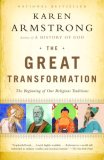Write your own review!
Rupa
Misinterpretation of Mahabharata
In “The Great Transformation”, Karen Armstrong writes about Hindu epic Mahabharata:
“The five Pandava brothers were all married to their sister, Draupadi. This was clearly unconventional, but the marriage recalled the ancient ritual of the Asmavedya, the horse sacrifice, which bestowed sovereignty on the king: the horse sacrifice, which bestowed sovereignty on the king: during the rite, the queen had some form of simulated sex with the sacrificial stallion, and was thus able to transmit the dominion it represented to her husband. In the epic, Draupadi represented royal authority, which she passed on to her brothers.” Page 366.
None of the Hindus in the world have ever heard of this – that Pandava was married to their sister! Where did Armstrong pick this gem from? Mahabharata is the most loved epic familiar to all Hindus and its characters and events steeped into their psyche from childhood. The fact that Draupadi was the daughter King Drupad of Panchali who had been won by Arjuna, one of the Pandava brothers, during her Swoyembar (the ancient groom selecting ceremony where princes assembled at the court and went through several tests and competitions to impress and win the hand of the marriageable Kshatriya princess). After the ceremony, he went back to their dwelling place (in a forest where they were living in exile) and shouted from a distance to his mother that he had with him a wonderful prize, but Kunti, his mother, asked him to share whatever he had won with his brothers. Thus Arjuna had no choice but to share Draupadi. The most it can be said about this episode is the intervention of fate and the possible social practice of that time when polyandry was still perhaps acceptable, if not common. But where is this angle of Pandava having a sister and all of their getting married to her rise from? At least those familiar with the Mahabharta have not heard of it.
Going through the bibliography, in which she cites a very few Indian authors, she listed a few such as: K.M Ganguly, V. S. Sukhatankar, Romila Thapar. I have not read these authors, but have they insinuated something like this? There is no way to know what was the criteria for her to select her references, what version of Mahabharata did she read and with what state of mind? For Hindus, though, its indeed to big jolt to know these heroes committed grave crime of incest which is one of the four gravest sins in Hinduism (others are defiling a girl, coveting one’s guru’s wife and killing a child). Is this misappropriation a result of negligence, a bias or simply a deliberate decision? Then why should she do that? She is known for her empathy and understanding, a thorough research and a historical sense, after all she is credited with giving make-over to all warring religions – Judaism, Christianity and Islam - as common religions of compassion. When it comes to Hinduism, however, her research and interpretations leave much to desire. There are other instances, too, in the book which will make Hindus or those familiar with Hinduism wonder just why would she would chose to interpret that way. Such lapse was not expected of the scholar and spiritual personality of her stature.
Glen Sanderson
Another useful perspective
This book is probably more directed to the lay reader who does not have a theology or philosophy background. Like her other books, it is well written. I believe Karen Armstrong, more than most authors, writes clearly and can take very complex subjects and make them interesting and informative to the reader. This book is no different.
As a reader, I learned that there is always more than one perspective on any subject. A reviewer can question Karen Artmstrong's interpretation of facts (or even the facts) , but I repect her intellect and her courage to express her views on a subject which many people have only a black or white perspective.
I would rate some of her other books, such as "The History of God", at a much higher level. Her books on Jerusalem and the Crusades were also very informative. I have read most of her books, and " The Great Transformation" is an adequate addition to Armstrong's thought provoking books.
Martin Kent
A feel good read?
The Great Transformation is typical of Armstrong's popularizing work. If you like to imagine great spiritual ideas emerging out of the human soul, this is a book for you. If you want to understand religion and its role in society you will need to look elsewhere. Ms. Armstrong cherry picks her history, and invents it where not pickable, to develop her position. To begin with there is no "axial age" in any meaningful sense unless you are trying to create some spiritual reality that to my mind does not exit. Her accessible writing style does not compensate for the conceptual and intellectual failures of this story.

 Book Reviewed by:
Book Reviewed by:





